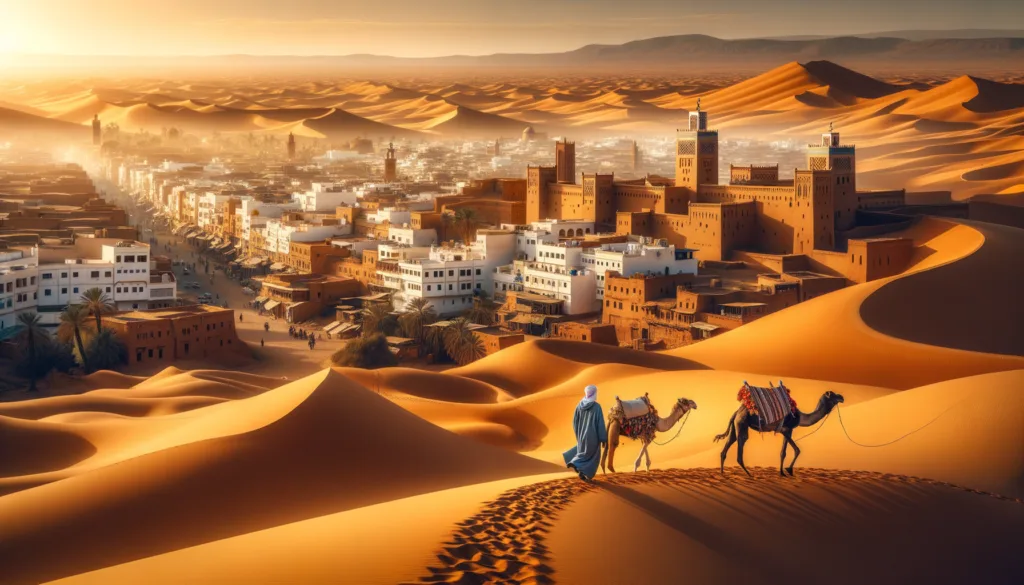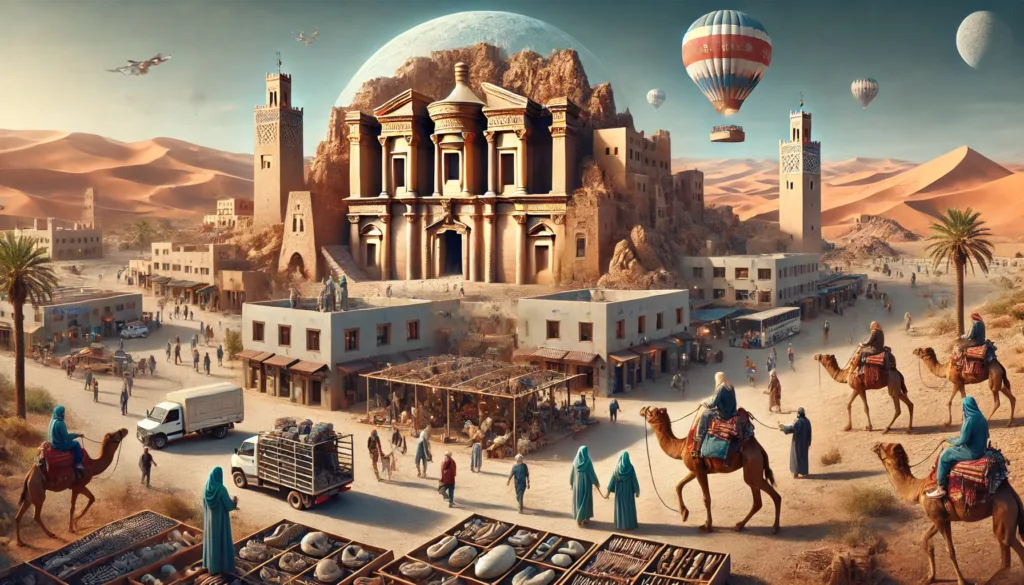
Morocco, a land of vibrant culture, breathtaking landscapes, and deep-rooted history, serves as the perfect gateway to one of the world’s most mesmerizing natural wonders—the Sahara Desert. Travelers looking to experience the endless golden dunes, striking sunsets, and nomadic traditions often begin their journey from one of Morocco’s key gateway cities, each offering a unique route into the vast expanse of sand.
Whether adventurers seek the dramatic dunes of Erg Chebbi, the remote beauty of Erg Chigaga, or a quick desert escape, Morocco provides an array of entry points catering to different travel styles. This guide explores the essential gateway cities and what each has to offer, providing insights into landscapes, activities, and travel logistics to help you plan an unforgettable Sahara adventure.
Merzouga – The Iconic Sahara Experience
Merzouga’s Location and Setting
Nestled in eastern Morocco near the Algerian border, Merzouga is the quintessential gateway to the Sahara Desert. This small, sleepy village is the doorstep to Erg Chebbi, a spectacular sea of towering sand dunes that stretch as high as 150 meters, creating an otherworldly landscape that draws travelers from around the globe.
Exploring Erg Chebbi’s Dunes
Erg Chebbi’s dunes are among the most sought-after desert landscapes in Morocco, famed for their golden hues that change color with the shifting sunlight. Unlike the desert areas near Zagora or M’Hamid, Erg Chebbi’s massive, rolling dunes provide the classic Sahara experience seen in postcards and films.
Exciting Activities for Visitors
- Camel Treks: The most iconic way to explore Erg Chebbi is by camel, following the ancient routes once used by Berber traders.
- Desert Camps: Spend a night under the stars in a traditional Berber camp, enjoying local music, Moroccan cuisine, and the profound silence of the desert.
- Sandboarding: Adventure seekers can glide down the dunes on sandboards, experiencing the desert in an exhilarating way.
Getting to Merzouga
Reaching Merzouga requires a long but rewarding journey. The most common starting point is Marrakech, with multiple travel options:
- By Car: A scenic 9-hour drive passing through the Atlas Mountains and picturesque Kasbahs.
- By Bus: Direct buses from Marrakech and Fez offer an affordable travel option, typically taking 10-12 hours.
- By Guided Tour: Many travelers opt for multi-day tours, which include stops at Ouarzazate, Todgha Gorge, and other landmarks along the way.
Despite the long journey, Merzouga offers one of the most visually striking and immersive desert experiences in Morocco, making it well worth the trek for those seeking the ultimate Sahara adventure.
Zagora – The Accessible Option
Location and Landscape
Nestled in Morocco’s scenic Draa River valley, Zagora is one of the most accessible gateways to the Sahara. Unlike Merzouga’s towering sand dunes, the desert landscape near Zagora is more understated, with smaller, rolling dunes and vast, arid plains decorated with acacia trees and date palm groves.
Proximity to Marrakech
One of Zagora’s biggest advantages is its relative proximity to Marrakech. Located approximately 360 kilometers away, it takes about 6 to 7 hours by road to reach Zagora, making it feasible for travelers with limited time who still want a taste of the Sahara. This has made Zagora a popular choice for quick desert getaways.
Activities and Desert Experience
- Camel Treks: Embark on an overnight camel trek into the desert, where visitors can witness a breathtaking sunset and enjoy a night in a traditional Berber camp under the stars.
- 4×4 Excursions: For those seeking a more comfortable and thrilling adventure, 4×4 desert tours allow for a faster-paced exploration of the region.
- Cultural Encounters: Meet the local nomadic communities and explore the nearby Kasbahs for a glimpse into Morocco’s rich desert heritage.
Tour Options and Key Attractions
Zagora offers a variety of well-organized desert tours, ranging from one-day excursions to extended multi-day adventures. Many trips include guided visits to the famous Aït Benhaddou, a UNESCO-listed kasbah, and stops at scenic locations like the Draa Valley’s lush palm groves.
Other Notable Gateway Cities

Ouarzazate – The “Gateway to the Sahara”
Often referred to as the “Door of the Desert,” Ouarzazate is a natural starting point for countless Sahara tours. The city is famed for its cinematic landscapes, with locations featured in films such as Gladiator and Game of Thrones.
Highlights:
- Aït Benhaddou: A spectacular and well-preserved ksar (fortified village).
- Atlas Film Studios: A must-visit for film enthusiasts, offering insights into Morocco’s role in major productions.
Erfoud – Fossils and Nomadic Culture
Known as Morocco’s “Fossil Capital,” Erfoud is a major stopping point before reaching the desert. Its rich geological history and proximity to Erg Chebbi make it both a scientific and cultural treasure.
Key Attractions:
- Fossil Workshops: Explore Erfoud’s fossil markets, where ancient marine fossils are transformed into stunning sculptures and household items.
- Nomadic Encounters: Immerse yourself in the traditions of the region’s nomadic Berber tribes.
M’Hamid – The Edge of the Sahara
M’Hamid is the last inhabited village before the immense Sahara begins in earnest. Unlike more developed desert towns, M’Hamid offers a raw, untamed experience with direct access to the remote Erg Chigaga dunes.
Why Visit?
- Seclusion and Authenticity: Perfect for travelers seeking an off-the-grid adventure.
- Erg Chigaga: Vast, untouched dunes reaching up to 300 meters, offering a wilder alternative to Erg Chebbi.
Whether you’re looking for a quick desert escape or a deep dive into Morocco’s Saharan landscapes, these unique gateway cities each offer something special for every kind of traveler.
Travel Considerations for a Sahara Desert Trip
Travel Logistics
Reaching the Sahara Desert from Morocco’s main cities requires considerable travel time. Marrakech and Fez serve as the primary starting points, with journeys to Merzouga, Zagora, or M’Hamid taking several hours.
By Road
Most travelers opt for private tours, rental cars, or long-distance buses. A drive from Marrakech to Merzouga via the Tizi n’Tichka pass can take over nine hours, while the journey to Zagora is slightly shorter at around six hours. Erfoud and M’Hamid require similar long-haul trips but offer rewarding landscapes along the way.
By Organized Tour
Organized tours simplify the logistics by handling transportation, accommodations, and excursions. These tours often include scenic stops at places like Ait Benhaddou, Dades Valley, and the Todra Gorge, making the journey a more immersive experience.
Seasonal Considerations
Best Times to Visit
Spring (March to May) and autumn (September to November) are the most favorable seasons for a Sahara experience. During these months, daytime temperatures are comfortable, and nights remain mild, allowing for an enjoyable desert stay.
Weather Challenges
- Summer (June to August): Temperatures can soar above 45°C (113°F), making desert excursions exhausting and potentially dangerous.
- Winter (December to February): While daytime remains pleasant, nighttime temperatures can drop drastically, sometimes nearing freezing, requiring proper cold-weather gear.
Conclusion
Morocco’s Sahara Desert is a bucket-list destination, but selecting the right gateway city can shape your overall experience. Whether you seek the towering dunes of Erg Chebbi in Merzouga, the more accessible landscapes near Zagora, or the untouched splendor of Erg Chigaga via M’Hamid, each offers its own unique adventure.
The journey to the desert is part of the magic. Road trips through the Atlas Mountains, valleys dotted with ancient kasbahs, and interactions with Berber communities enrich the travel experience. Whether on a camel-backed trek or a 4×4 excursion, the Sahara’s mesmerizing beauty will leave an unforgettable impression.
For travelers planning their trip, it’s essential to consider travel distances, logistical comfort, and seasonal conditions. Those with limited time may prefer Zagora, while adventure-seekers and photography enthusiasts might find Merzouga and Erg Chigaga more rewarding.
Whatever the chosen route, the Moroccan Sahara promises breathtaking landscapes, profound tranquility, and a taste of timeless desert culture.
FAQ
Which Moroccan cities are the main gateways to the Sahara Desert?
Merzouga and Zagora are the most popular destinations for international tourists heading to the Sahara. Merzouga, located near the iconic Erg Chebbi sand dunes, is ideal for those seeking a classic desert experience. Zagora, situated in the Draa River Valley, is closer to Marrakech and often included in shorter desert tours.
What makes Merzouga a preferred destination for a Sahara experience?
Merzouga sits on the edge of Erg Chebbi, offering breathtaking sand dunes and a truly immersive desert adventure. Visitors can enjoy camel treks, spend nights in luxury desert camps, and try activities like sandboarding.
How does Zagora compare to Merzouga?
Zagora provides a desert experience that is more accessible from Marrakech, making it a great option for shorter trips. However, its landscape is less dramatic than Erg Chebbi. This makes it a good choice for travelers with limited time.
Are there other notable towns near the Sahara?
Yes! Some important towns include Ouarzazate, known as the “Gateway to the Sahara,” Erfoud, famous for its fossils and desert access, and M’Hamid, which serves as the entry point to the remote Erg Chigaga dunes.
How can I reach the Sahara Desert from major Moroccan cities?
Most travelers start their journey in Marrakech or Fez. The trip to the desert can take 8-10 hours by car, so many tourists opt for organized tours that include transportation, guided excursions, and stops at notable sites like the Atlas Mountains and ancient kasbahs.
What is the best time of year to visit the Sahara Desert?
The best times to visit are in spring (March to May) and fall (September to November) when temperatures are moderate. Summer can be extremely hot, while winter nights can be very cold.
What activities can I do in the Sahara Desert?
Popular activities include camel trekking, overnight stays in traditional or luxury desert camps, sandboarding, 4×4 desert tours, and stargazing in the vast open skies.
Is it safe to visit the Sahara Desert?
Yes, the Sahara in Morocco is generally safe for tourists. Most travelers explore the desert through reputable tours, which provide experienced guides, transportation, and accommodation services.
What should I pack for a desert trip?
Essentials include light, breathable clothing for daytime, warm layers for chilly nights, sunscreen, sunglasses, a hat, a scarf to protect against sand, and plenty of water.
Why should I consider an organized tour instead of traveling independently?
Organized tours simplify transportation and logistics while offering a richer experience through guided insights and planned activities. They provide access to remote locations and include stops at cultural and natural landmarks along the way.